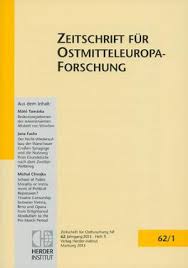Landesfreiheiten und Freiheit der Krone in den böhmischen Ländern 1547 und 1619. Zur Innovationsfähigkeit ständischen politischen Denkens
Freedoms of the country and freedom of the crown in the Bohemian Lands in 1547 and 1619. The estates' capacity to innovate their political thinking
Author(s): Winfried EberhardSubject(s): Political history, Social history, 16th Century, 17th Century
Published by: Verlag Herder-Institut
Keywords: Freedoms; country; freedom of the crown; Bohemian Lands; 1547 and 1619; political thinking;
Summary/Abstract: Since the Hussite Revolution, in the Bohemian Lands freedoms of the country formed the estates' basic political concept with regard to the ruler, and since about 1500, for the view and practice of sovereignty of the lands Community (Landesgemeinde), especially among the nobility. According to a widespread opinion, the Bohemian estates - forced onto the defensive by king Ferdinand I - defended these old rights out of mere "legal conservatism", unable to innovate their political views. This article, however, intends to show by means of two examples that the Bohemian estates did have the capacity to create, out of the defensive, concepts of a representational system that went beyond the Status quo, towards a republic of the nobility. During the rebellion of 1547 against the king's violation of their freedoms, the estates presented a constitutional draft that, in various ways, aimed at an innovative extension of the estates' representation and participation (particularly by increasing the influence of the district assemblies) in a new vertical system of representation, restricted the king's prerogatives and made freedoms of the country the highest constitutional principle. The second example is the well-known Confoederatio Bohemica, which the Protestant estates in the Bohemian Lands established during their second uprising in 1619. It went far beyond the draft of 1547. Firstly, it united all crown lands in an alliance of members with equal rights, and secondly, not only extended the estates' prerogatives against the king, but also established a vertical structure of representation, at whose centre were the Protestant defensors' boards and which, to a much greater extent than previously, was able to create an institutional Integration of all crown lands. Therefore, we can for the first time recognize a system of "crown freedoms" in this Constitution of a republic of the nobility.
Journal: Zeitschrift für Ostmitteleuropa-Forschung
- Issue Year: 57/2008
- Issue No: 1
- Page Range: 62-80
- Page Count: 19
- Language: German

